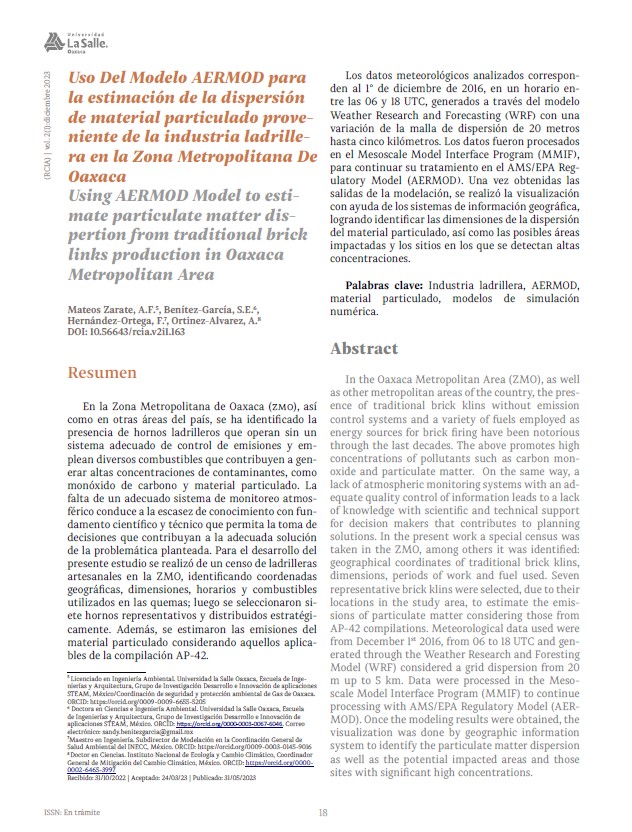Uso del Modelo AERMOD para la estimación de la dispersión de material particulado proveniente de la industria ladrillera en la Zona Metropolitana De Oaxaca
DOI:
https://doi.org/10.56643/rcia.v2i1.163Palabras clave:
Industria ladrillera, AERMOD, material particulado, modelos de simulacion numericaResumen
En la Zona Metropolitana de Oaxaca (zmo), así como en otras áreas del país, se ha identificado la presencia de hornos ladrilleros que operan sin un sistema adecuado de control de emisiones y emplean diversos combustibles que contribuyen a generar altas concentraciones de contaminantes, como monóxido de carbono y material particulado. La falta de un adecuado sistema de monitoreo atmosférico conduce a la escasez de conocimiento con fundamento científico y técnico que permita la toma de decisiones que contribuyan a la adecuada solución de la problemática planteada. Para el desarrollo del presente estudio se realizó de un censo de ladrilleras artesanales en la ZMO, identificando coordenadas geográficas, dimensiones, horarios y combustibles utilizados en las quemas; luego se seleccionaron siete hornos representativos y distribuidos estratégicamente. Además, se estimaron las emisiones del material particulado considerando aquellos aplicables de la compilación AP-42. Los datos meteorológicos analizados corresponden al 1° de diciembre de 2016, en un horario entre las 06 y 18 UTC, generados a través del modelo Weather Research and Forecasting (wrf) con una variación de la malla de dispersión de 20 metros hasta cinco kilómetros. Los datos fueron procesados en el Mesoscale Model Interface Program (mmif), para continuar su tratamiento en el AMS/EPA Regulatory Model (aermod). Una vez obtenidas las salidas de la modelación, se realizó la visualización con ayuda de los sistemas de información geográfica, logrando identificar las dimensiones de la dispersión del material particulado, así como las posibles áreas impactadas y los sitios en los que se detectan altas concentraciones.
Citas
Castellanos, J., y Treviño, E. (2006). Estructura de bosques de pino pátula bajo manejo en Ixtlán de Juárez, Oaxaca, México. Madera bosques, 14(2), 51-63.
EPA (2003). AERMOD: Latest Features and Evaluation Results. U.S. Environmental Protection Agency; AERMOD_MEP.
EPA (2023). AERMOD: Model Formulation. U.S. Environmental Protection Agency; Office of Air Quality Planning and Standards Air Quality Assessment Division.
INECC y Semarnat (2018). Informe Nacional de Calidad del Aire 2017, México (No. 1; p. 317). Coordinación General de Contaminación y Salud Ambiental.
INEGI, Instituto Nacional de Estadística y Geografía (2023, diciembre 10). Censos y conteos de población y vivienda, censo 2020. https://inegi.org.mx/datosabiertos/
Instituto Estatal de Ecología y Desarrollo Sustentable (2013). Estudio de Factibilidad Legal, Ambiental, Social y Económica para reducir o evitar las emisiones a la atmósfera del Sector Ladrillero en la Zona Metropolitana de Oaxaca. (No. 1; Diagnóstico Ambiental, p. 30). Instituto Estatal de Ecología y Desarrollo Sustentable; Diagnóstico Ambiental.
Mateos Zarate, A. F. (2023). Evaluación de la aplicación del modelo AERMOD para estimación de contaminantes atmosféricos emitidos por la industria ladrillera en Oaxaca. [Reporte de Investigación, Universidad La Salle Oaxaca]. Repositorio Académico ULSA Oaxaca.
Mendoza, A., y García, M. (2009). Aplicación de un modelo de calidad del aire de segunda generación a la zona metropolitana de Guadalajara, México. Rev. Int. Contam. Ambiental, 25(2), 73-85.
OMS, Organización Mundial de la Salud (2018, junio 23). Nueve de cada diez personas de todo el mundo respiran aire contaminado. https://www.who.int/es/news/item/02-05-2018-9-out-of-10-people-worldwide-breathe-polluted-air-but-more-countries-are-taking-action
SEA, Servicio de Evaluación Ambiental, Gobierno de Chile (2023). Guía para el uso de modelos de calidad del aire en el Servicio de Evaluación Ambiental (p.16). Segunda edición.
Tejeda Le Blanc, & Cia., S.C. LT Consulting (2011). Inventario de emisiones de gases criterio para el estado de Oaxaca (p. 90). Instituto Estatal de Ecología y Desarrollo Sustentable.
US-EPA (2023, noviembre 13). Method Validation and Peer Review Policies and Guidelines. https://www.epa.gov/measurements-modeling/method-validation-and-peer-review-policies-and-guidelines

Descargas
Publicado
Cómo citar
Número
Sección
Licencia
Derechos de autor 2023 Alan Fernando Mateos Zarate, Sandy-Edith Benitez-Garcia, Francisco Hernandez-Ortega, Abraham Ortinez-Alvarez

Esta obra está bajo una licencia internacional Creative Commons Atribución 4.0.
Los autores/as que publiquen en esta revista aceptan las siguientes condiciones:
- Los autores/as conservan los derechos de autor y ceden a la revista el derecho de la primera publicación, con el trabajo registrado con la licencia de atribución de Creative Commons 4.0, que permite a terceros utilizar lo publicado siempre que mencionen la autoría del trabajo y a la primera publicación en esta revista.
- Los autores/as pueden realizar otros acuerdos contractuales independientes y adicionales para la distribución no exclusiva de la versión del artículo publicado en esta revista (p. ej., incluirlo en un repositorio institucional o publicarlo en un libro) siempre que indiquen claramente que el trabajo se publicó por primera vez en esta revista.
- Se permite y recomienda a los autores/as a compartir su trabajo en línea (por ejemplo: en repositorios institucionales o páginas web personales) antes y durante el proceso de envío del manuscrito, ya que puede conducir a intercambios productivos, a una mayor y más rápida citación del trabajo publicado.





